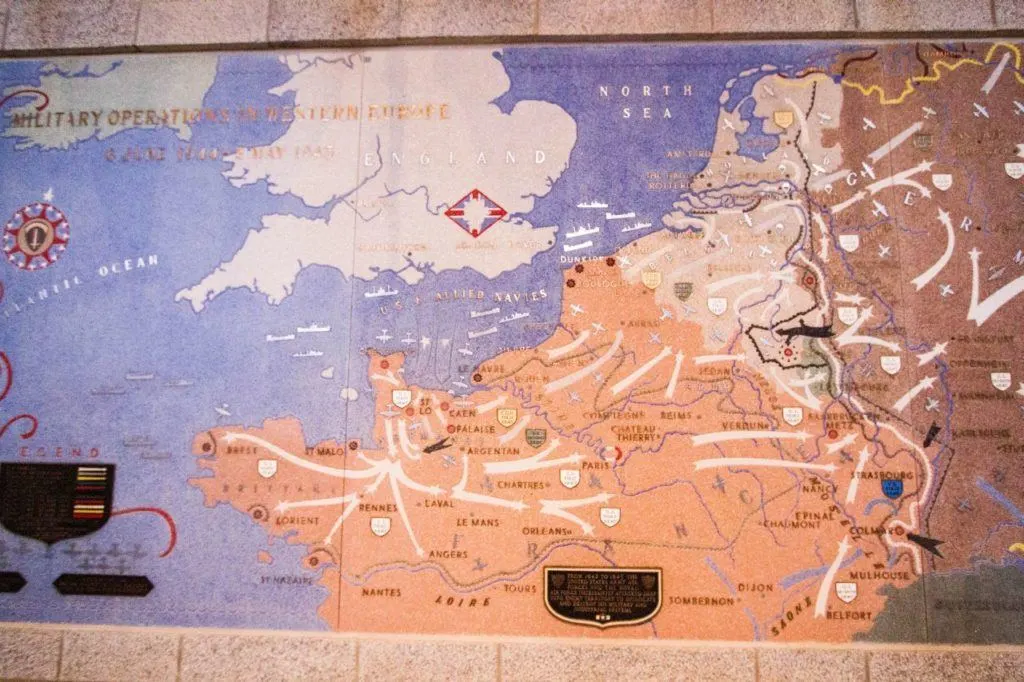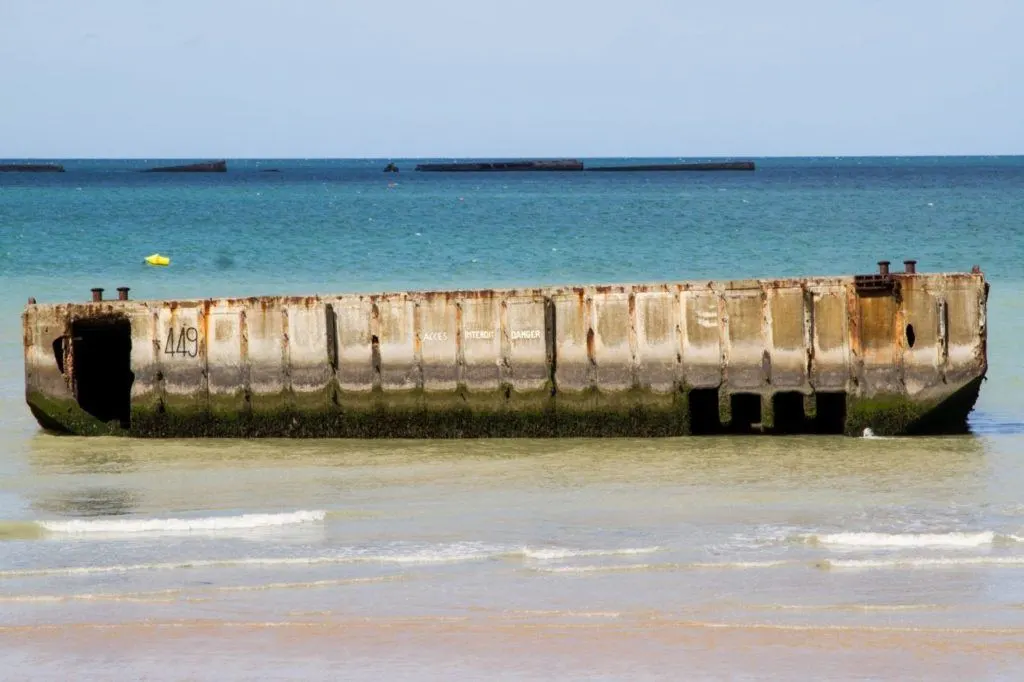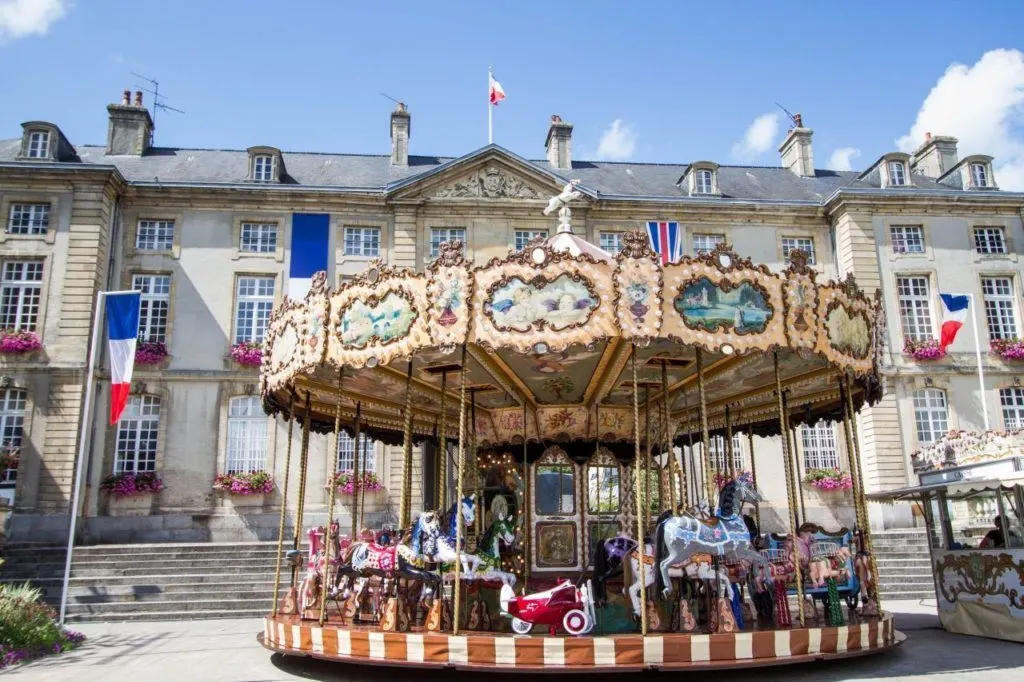Take a drive with us as we meander, ponder and memorialize those that fought in World War Two on the beaches of Normandy.
When planning a recent trip to western France, we knew we had to include some time for Normandy even though most of our time would be spent in neighboring Brittany. We decided on a two day detour to check out the beaches and other D-Day sites along the coast.
This turned out to be enough time, though to be sure, we could have easily extended it a day or two and spent more time with some of the other attractions in this beautiful coastal stretch of France. As we were driving the hedge-lined country lanes and secondary roads I couldn’t stop trying to imagine what it must have been like fighting through this area.

Places to Go to See World War Two Sites
The roads are completely hidden from view with thick, impenetrable overgrown rock walls. And the farm land is broken up into small plots forming a quilted patchwork of hedge-lined open fields. Once the soldiers broke through one hedge they had no idea what, or who, was waiting on the other side of the next. It gives you an odd, claustrophobic feeling as you drive along, with no idea of what is on the left, right, or indeed, in front of you as the road winds up and down and around rolling hills.

I’m sure the liberating Allies finally broke through those last hedgerows on their way to Bayeux with immeasurable relief. They met some resistance in the streets of the city but were able to repel the German forces and liberate the town without any heavy artillery or bombardment and the city still holds an amazing display of beautiful architecture.

Bayeux is perfectly situated for an inland base of operations for tourists interested in taking in tall of the D-Day invasion history (source). It lies a few miles from the coast and is large enough to have a good selection of hotels, shops, and restaurants. And, thanks to the minimal damage during World War Two, it’s attractions go well beyond the 20th century.
Here you’ll find the Tree of Liberty in a small square next to the cathedral. This huge tree has a commanding presence. It was planted at the end of the eighteenth century to commemorate the changes sweeping through France at that time (source). It still stands today as a symbol of peace and freedom and now serves as the focal point of a nightly light show spectacular.

The cathedral itself was built in the 13th century and is a prime example of Norman architecture. Inside the nave is cool, peaceful and awesome, all at the same time. But perhaps the biggest draw in Bayeux is the incredible Bayeux tapestry, a rare 11th century cloth artifact covered with embroidered scenes depicting the Norman conquest of England. This UNESCO Memory of the World should not be missed!

Heading out of Bayeux toward the coast, we came across the small port town of Arromanches. Here the allies built a hastily constructed artificial temporary harbor (called Mulberry) to allow the unloading of heavy equipment, and remains of the artificial port can be seen today still floating out in the bay or on the beach during low tides (source).
Though you might be tempted to climb atop one of these massive steel and concrete pier pieces, it is wise to resist the temptation to climb aboard as they are rusting, jagged hulks that will give you more to remember then a photograph if you get too up-close and personal (think hepatitis or tetanus!).

The town itself was largely spared the brunt of the fighting, in large part due to the fact the allies had planned on using it for their port and didn’t want to have to rebuild too much. So it still holds much of the charm of a quaint, French sea-side village. This is also a good location to use as a base as there are numerous lodging options from camping to 3 star hotels right on the beach.
Plenty of dining options abound, as well, and you can get anything from a light breakfast of coffee and croissant up to a gourmet Michelin Guide recommended meal. Enjoy a stroll along the sea wall or out on the beach if the tide is out or even take a plunge if the weather is nice.

The golden beaches along this coast are long, wide and sandy with steady small rollers and otherwise calm waters, perfect for swimming.
Further along the coast, at Omaha Beach, lie the remains of nearly 10,000 American soldiers in the American Military Cemetery of Normandy. This sprawling somber site with its endless rows of brightly shining white crosses and stars of David, lies atop the cliffs overlooking one of the deadliest beach landing sites a fitting memorial.
This is a very popular destination, especially crowded in the summer. Here the crowds, picnickers, running children, school outing groups, and large tour groups really detracted from the overall feel of the place. I recommend arriving early in the morning to beat the crowds and hopefully catch some of the atmosphere and solemnity before the crowds arrive.

To be sure, there are many, many more sites to be seen. You can easily get to all of the sites in your car over the course of a two or three day visit. Other options are available, such as small tours, large tours, or even hiring a taxi for the day. However you do it, be sure and take some time to get out and walk along the beaches, trek through the hedgerows and farmlands, and stand face to face with the memory and sacrifices so many young men gave to protect freedom.
Other World War Two Articles to Read:
Breaking Down the World War Two History of Berchtesgaden
11 Perfect Things to do in Nuremberg
A Somber Visit to Dachau Concentration Camp
Have you visited the World War Two Sites of Normandy?

Rosie @Eco-Gites of Lenault
Wednesday 6th of January 2016
I live in Normandy and am gradually working my way round the cemeteries, museums and sites of WWII interest. It'll take me a while though but I enjoy them all is a poignant way, knowing I can be there thanks to the brave men who fought here over 70 years ago. Popping by very late from #AllABoutFrance
Corinne Vail
Thursday 7th of January 2016
Rosie, You live in such a wonderful area of France. Lucky you.
Phoebe @ Lou Messugo
Thursday 17th of December 2015
I've been to some of the beaches and some cemeteries (in Picardie not Normandy) but I haven't really "done" the WWII sights in Normandy and I really should. I love the last photo of the merry-go-round, it could only be France. Thanks for linking up to #AllAboutFrance Corinne.
Corinne Vail
Thursday 17th of December 2015
Phoebe, Of course, anytime. You really should go to the beaches of Normandy!
Sara @ Simply Sara Travel
Tuesday 15th of December 2015
Lovely, informative post! I took a tour of a lot of the WWII beaches and sites in Normandy and it was such a moving experience. Especially visiting the American cemetery and getting part of a visual picture of all the lives taken by the invasion, and seeing how young the men were. Such a sobering and powerful day trip that I will always remember.
Corinne Vail
Tuesday 15th of December 2015
Sara, Normandy is a huge memorial to D-Day. Everywhere you go, there is a reminder. We learned so much.
Anda
Sunday 13th of December 2015
I've never been in Normandy. It must be pretty sad to visit these sites but it surely is educational. Those young people's graves are such a chilling reminder of the horrors of war.
Corinne Vail
Monday 14th of December 2015
Anda, It was sad, but I think going on a more rainy/dreary day would have helped. The day we went was just gorgeous.
Mary {The World Is A Book}
Saturday 5th of December 2015
Beautiful photos and I especially love that carousel one. This is a wonderful side trip and one we'd love to do someday. Those historical sites are so educational for all of us and my husband is a history buff who would enjoy a visit here.
Corinne Vail
Saturday 5th of December 2015
Mary, The entire region is really worth some time. Lots to do, gorgeous food, and beaches!